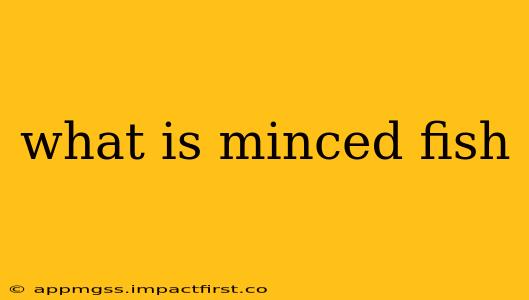Minced fish, also known as fish mince or fish paste in some regions, is simply fish that has been finely ground or processed into a paste-like consistency. Unlike filleted fish, which retains its recognizable structure, minced fish is broken down into small particles, making it incredibly versatile for a wide array of culinary applications. This guide will explore the different types, uses, and benefits of this often-overlooked ingredient.
What are the Different Types of Minced Fish?
The type of minced fish available will often depend on local availability and fishing practices. Commonly used species include:
- White fish: Cod, haddock, pollock, and tilapia are frequently used due to their mild flavor and relatively firm texture even when minced.
- Fatty fish: Mackerel, salmon, and tuna can be minced, lending a richer flavor and fat content to the final dish. However, their oil content can impact texture, potentially requiring careful handling and cooking methods.
- Mixed species: Many commercial minced fish products are blends of various species, offering a consistent product and potentially lowering the overall cost.
How is Minced Fish Made?
The process for creating minced fish can vary. Generally, it involves:
- Cleaning and filleting: The fish is cleaned, gutted, and filleted to remove bones and unwanted parts.
- Grinding or processing: The fillets are then processed using industrial-grade grinders or similar equipment to break down the fish into a fine paste. The degree of mincing can vary, producing textures ranging from coarse to extremely fine.
- Optional additions: Depending on the intended use, salt, preservatives, or other ingredients might be added during or after processing.
What are the Common Uses of Minced Fish?
Minced fish’s versatility shines in its diverse culinary applications:
- Fish cakes and patties: This is a classic use, where the minced fish forms the base, often combined with binders like breadcrumbs and seasonings.
- Soups and stews: Adding minced fish to soups adds protein and a delicate flavor, often melding seamlessly into the overall broth.
- Stuffings and fillings: Minced fish can be used as a flavorful filling for savory pastries, dumplings, or vegetables.
- Fishballs and croquettes: These popular snacks rely on minced fish as their main ingredient, often featuring a crispy outer coating.
- Fish spread or pâté: Minced fish can form the base for creamy spreads or pâtés, often enhanced with herbs, spices, and other flavorings.
- Fermented fish products: In some cultures, minced fish undergoes fermentation to create unique, pungent, and umami-rich products.
Is Minced Fish Healthy?
Like all fish, minced fish is a good source of protein and omega-3 fatty acids, crucial for heart health and brain function. However, the nutritional value can vary significantly based on the type of fish used. Always check the nutritional information on the packaging if you are concerned about specific nutrients or if you have dietary restrictions.
What is the Difference Between Minced Fish and Fish Paste?
While often used interchangeably, there can be subtle differences between "minced fish" and "fish paste." Minced fish generally refers to a coarsely or finely ground mixture of fish flesh, while fish paste often suggests a smoother, more processed product, potentially containing added ingredients like salt and preservatives. The distinctions can be blurry, depending on regional terminology and manufacturing practices.
Where Can I Buy Minced Fish?
Minced fish can be found in various places depending on your location:
- Fishmongers: Local fish markets are an excellent source for fresh, high-quality minced fish.
- Supermarkets: Many larger supermarkets now stock pre-packaged minced fish in their refrigerated sections.
- Asian grocery stores: These often carry a wider variety of minced fish, including specialized products from different regions.
How Do I Store Minced Fish?
Fresh minced fish should be treated like any other fresh fish and stored in the refrigerator. It's best to use it as soon as possible after purchase. Properly refrigerated, it should remain fresh for 1-2 days. Frozen minced fish will have a much longer shelf life.
This comprehensive guide provides a thorough overview of minced fish, encompassing its types, uses, health aspects, and storage considerations. Understanding the versatility and benefits of this ingredient opens up a world of culinary possibilities.
